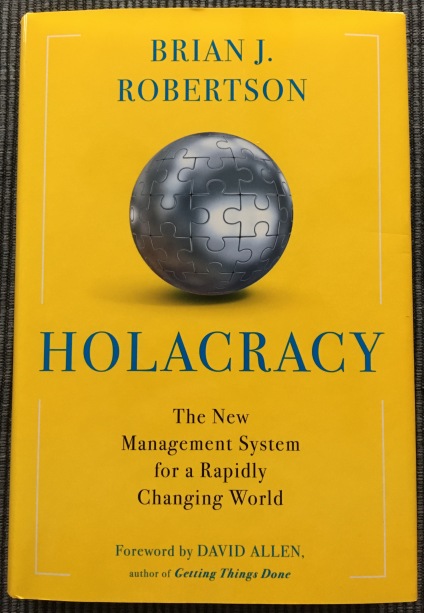
Holacracy
In approximately two weeks we will begin the next book is, The Science of Successful Organizational Change. Remember to use the link to buy a copy to support the podcast and blog. The reread will be led by Steven Adams. I am looking forward to sitting on the other side of the table during the next re-read!
Chapter 10 completes Holacracy. This week’s chapter is titled, The Experience of Holacracy. This chapter sums up the changes that are generated when an organization adopts Holacracy. Adopting Holacracy requires learning different ways to control and manage; perhaps it would be better to say lead a company. While every organization has different issues as they adopt Holacracy, Robertson has observed a few fairly common themes.
Toppling the Hero
Heroic management does not fit the Holacracy model. The distribution and democratization of decision making create an environment in which the hero is out of step with the organization. Heroic forms of management concentrate decision making in one spot: the heroic CEO which forms a single point of failure. Travis Kalanick, the CEO of Uber is an example of the type of problem that occurs when decision making is concentrated in one heroic figure. The organization is limited to the decision making throughput of the hero.
The idea of reducing the dependence on a hero has been a topic of discussion in organizational circles as long as I can remember. While the reliance on heroics has been reduced, embracing Holacracy still requires a culture shift. That culture shift requires heroic leaders to give up the power that provides them comfort (and probably and endorphin hit when they ride to the rescue). At the same time roles that have avoided making decisions find fewer places to hide. In either case, embracing Holacracy requires abandoning what is currently comfortable to find a new equilibrium in which authority and leadership are redistributed.
Operating as the Victim
The parent-child relationship (see blog) represents the standard management-worker operating model. This relationship is often so ingrained that shifting the relationship requires significant energy and can cause consequences. The redistribution of authority that is central to Holacracy changes the relationship between all of the roles within an organization. Holacracy makes it more difficult to spend time grumbling about a problem when you have the authority to change the process.
One of the signs of change discussed by Robertson is when people begin to feel discomfort about not seeking consensus, begin apologizing for making certain decisions, or for rocking the organizational boat. The discomfort is a sign that the parent-child relationship is evolving to something more akin to parent-adult relationship which is healthy for making decisions.
Moving Beyond a Personal Paradigm
Holacracy separates the idea of roles from individuals. The separation of person and role along the distribution of authority moves a team or organization away from the need to rely on an individual, but rather to rely on the role.
The Evolution of the Organization
This section reminds us that Holacracy helps an organization shift from a static representation to an evolving, dynamic structure in which governance and decision making is distributed.
Next week some final thoughts.
Remember to buy a copy of Holacracy (use the link to help support and defray the costs of the Software Process and Measurement Cast blog and podcast).
All entries in the re-read:
Week 1: Logistics and Introduction
Week 3: Distribution Authority
Week 4: Organization Structure
Week 7: Facilitating Governance
Week 8: Strategy and Dynamic Control
Week 10: When You Are Not Ready
Week 11: The Experience of Holacracy
June 25, 2017 at 9:12 pm
[…] Week 11: Experience of Holacracy […]
July 1, 2017 at 11:55 pm
[…] Week 11: The Experience of Holacracy […]
July 2, 2017 at 9:11 pm
[…] Week 11: Experience of Holacracy […]
July 8, 2017 at 12:42 pm
[…] Week 11: The Experience of Holacracy […]
July 8, 2017 at 12:45 pm
[…] Week 11: The Experience of Holacracy […]
July 8, 2017 at 12:46 pm
[…] Week 11: The Experience of Holacracy […]
July 8, 2017 at 12:48 pm
[…] Week 11: The Experience of Holacracy […]
July 8, 2017 at 12:52 pm
[…] Week 11: The Experience of Holacracy […]
July 8, 2017 at 12:53 pm
[…] Week 11: The Experience of Holacracy […]
July 8, 2017 at 12:54 pm
[…] Week 11: The Experience of Holacracy […]
July 8, 2017 at 12:55 pm
[…] Week 11: The Experience of Holacracy […]
July 8, 2017 at 12:56 pm
[…] Week 11: The Experience of Holacracy […]